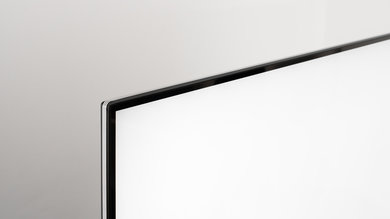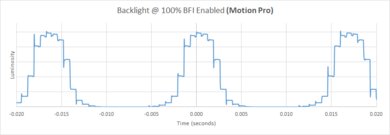The LG SM9500 is a good UHD IPS TV with good picture quality and impressive motion handling. It can get very bright in SDR and has excellent reflection handling, suitable for bright rooms with plenty of light. The contrast ratio is mediocre, as expected from an IPS TV, and the local dimming is bad at improving the dark scene performance in a dark room. It has a wide color gamut, can get very bright in HDR, and can display rich colors and bright highlights. The gray uniformity is mediocre and the noticeable dirty screen effect might bother demanding sports fans, but the viewing angles are good and the image remains accurate when viewed from the side. The SM9500 has a very low input lag, even for the most demanding gamers, and the response time is very fast so that fast motion has only a minimal blur trail.
Our Verdict
The LG 65SM9500 is a good TV for mixed usage. It has excellent reflection handling, can get very bright, and has wide viewing angles, so it's a great choice for large bright rooms where people might be watching from the side. It has a fast response time and motion is crisp to please sports fans. The SM9500 has a very low input lag, great for gaming, but can only deliver decent dark room performance, which will disappoint movie fans.
- Can get very bright.
- Image remains accurate at an angle.
- Very low input lag.
- Blacks look gray in a dark room.
The LG SM9500 is a decent TV for watching movies. Unfortunately, it does not have a high native contrast ratio and its poor black uniformity and the poor local dimming feature don't help much. Therefore, blacks tend to look gray in a dark room and this hurts the overall picture quality in a dark room. It can play movies judder-free from most sources and has a motion interpolation feature to please the soap opera effect fans.
The LG SM9500 is a great TV for watching TV shows. It has excellent reflection handling and a remarkable SDR brightness so you can easily place it in a very bright room. Also, you can move around when you casually watch your favorite TV show, and the image will remain accurate thanks to the wide viewing angles. Cable content is upscaled well and the TV has motion interpolation for those who enjoy the soap opera effect.
The LG 65SM9500PUA is a very good TV for watching sports. It has excellent reflection handling and a very fast response time that only leaves a small blur trail behind fast-moving content. Unfortunately, the gray uniformity is only mediocre and there is some dirty screen effect that might bother demanding sports fans. On the upside, the image remains accurate when viewed from the side so you can invite a group of friends to watch the big game, without worrying who will sit on the side.
This is a great TV for playing video games. It has a remarkably low input lag and feels very responsive. Gamers will also appreciate the fast response time that only leaves a small blur trail in fast-moving content. The SM9500 also supports HDMI Forum VRR for a nearly tear-free gaming experience, but currently, this is only supported on the Xbox One.
This is a decent TV for watching HDR movies. The TV has a wide color gamut, can get very bright in HDR and can display a vivid image with bright highlights. HDR content on this TV looks best in a dim room where blacks don't matter as much. When viewed in a dark room, blacks tend to look like gray due to the TV's poor dark room performance.
This is a very good TV for playing HDR games mainly due to its low input lag and fast response time. If you play HDR games in a dim room where deep blacks are not that important, then you will enjoy a great HDR gaming experience. Unfortunately, the low contrast ratio and poor local dimming don't allow for deep blacks in a dark room.
This is a great TV for use as a PC monitor. It has a very low input lag and a very fast response time. When you move the mouse, the arrow on the screen responds instantaneously and you won't see much blur. The SM9500 can display proper chroma 4:4:4: so text looks crisp. As an IPS panel, the SM9500 doesn't have the risk of permanent burn-in but there is some temporary image retention.
Changelog
- Updated Nov 27, 2020: We've retested the input lag and supported resolutions with an HDMI 2.1 source and the latest firmware version 05.00.02.
- Updated Jul 27, 2020: Retested the VRR range.
- Updated May 21, 2020: Converted to Test Bench 1.5.
- Updated Feb 21, 2020: Converted to Test Bench 1.4.
Check Price
Differences Between Sizes And Variants
We tested the 65" (65SM9500), the only size available at the moment in the U.S. In Europe, the SM9500 is known as the SM9800 (SM98). Other than minor regional differences (especially inputs), we expect them to perform the same.
If someone comes across a different type of panel or if their LG 65SM9500 doesn't correspond to our review, let us know and we will update the review.
| Size | US Model | EU Model |
| 55" | N/A | 55SM9800PLA |
| 65" | 65SM9500PUA | 65SM9800PLA |
The LG 65SM9500 we reviewed was manufactured in March 2019.
Popular TV Comparisons

The LG SM9500 offers good performance for most viewing habits and is very well-suited for bright rooms. See our recommendations for the best TVs and the best smart TVs.
The LG SM9500 and the Vizio P Series Quantum 2018 have different panels, each with their advantages and disadvantages. The LG has an IPS panel and is more suitable if you have a large room with a wide seating arrangement and prefer to watch TV in a dim or a bright room, as its dark room performance is just decent. The Vizio, on the other hand, is more suitable if you watch TV in a dark room, as it can deliver excellent dark room performance, but you must sit straight in front to enjoy the most accurate image.
The Sony X850F is marginally better than the LG SM9500. The Sony has better gray uniformity, which is great if you're a sports fan. The X850F is also flicker-free, which is important for those that are bothered by flicker. The SM9500, on the other hand, can get brighter and is suitable for a very bright room. The LG has a local dimming feature that can provide some improvement with the appearance of blacks in a dark room. The LG also has a lower input lag, which is good news to gamers, but also shows some signs of temporary image retention.
The Samsung Q70R and the LG SM9500 use different panel technologies, each with their strengths and weaknesses. The Q70R is a better choice for watching in a dark room thanks to its exceptional contrast ratio and black uniformity. The SM9500 looks better in a brighter room and has wide viewing angles, so it's better for watching sports during the day with a large group of friends. The SM9500 is also a bit more future-proof, as it has 4 HDMI 2.1 ports, and it supports eARC.
The two TVs have different panels, but the Samsung Q80R has the 'Ultra Viewing Angle' technology that allows it to display wider viewing angles than typical VA panel TVs at the expense of a lower contrast ratio. For most uses, the Samsung Q80R is a much better TV than the LG SM9500. The Q80R has excellent dark room performance with deep blacks thanks to its effective local dimming support. Also, the image on the Q80R remains accurate for fairly large angles. The LG SM9500 still has wider viewing angles, so it's more suitable if viewing angles are the main concern. In most other cases, the Q80R is the better choice.

We buy and test dozens of TVs yearly, taking an objective, data-driven approach to deliver results you can trust. Our testing process is complex, with hundreds of individual tests that take over a week to complete. Most of our tests are done with specially designed test patterns that mimic real content, but we also use the same sources you have at home to ensure our results match the real-world experience. We use two main tools for our testing: a Colorimetry Research CR-100 colorimeter and a CR-250 spectroradiometer.
Test Results

The LG SM9500 is a 2019 upper mid-range UHD LED TV in LG's NanoCell series. It's the replacement of the LG SK9500 in LG's lineup and its competitors are the Sony X950G, the Vizio P Series Quantum, or other LED IPS TVs like the Sony X850F. Some might also compare it to some higher-end VA panels with the new wide angle technology, like the Samsung Q80R or Sony Z9F.
The design of the LG 65SM9500PUA is excellent. The stand is plastic with a silver finish and supports the TV well. However, if you nudge the TV, it wobbles significantly. The back is very plain and made of good quality plastic. Cable management is serviced through the hollow neck of the stand. The entire construction feels solid and looks premium, and you shouldn't have any issues with the build quality of this TV. It's almost identical to LG's flagship Nanocell TV, the 75SM9970PUA, though it has an 8k resolution.
The stand of the TV is plastic and resembles this year's SM8600, but with a metal finish. Although the stand supports the TV well, the TV wobbles a lot if nudged.
Footprint of the 65" TV stand: 32.6" x 12.5".
The back of the TV is plain with a horizontal line texture, and it's made of high-quality plastic. Just like the SM8600, the stand's neck is hollow (has a removable cover) and you can guide a few cables through to help with cable management.
The LG 65SM9500PUA is a thin TV. It's in the same ballpark as last year's SK9500. It won't stick out much if you wall-mount it.
The build quality is great. There are no gaps or loose ends, but the TV wobbles more than last year's SK9500. You should have no issues with the TV's build quality.
The stand has a plastic cover and in our case, the metallic skeleton was slightly exposed as you can see in the stand picture. We fixed this easily by clipping it back on, and it did not affect our testing in any way.
The LG 65SM9500PUA has a decent contrast ratio. This is expected for an IPS panel TV. When local dimming is enabled, the contrast ratio improves significantly. This is a very similar performance to last year's SK9500. Note that the contrast ratio can vary between individual units.
If you want a TV with deeper blacks, then check out the Samsung Q70R or the Vizio P Series 2018.
The local dimming helps improve the appearance of blacks on the TV. The performance, however, isn't very good and is in the same ballpark as last year's SK9500. When LED Local Dimming is set to 'High', it's very aggressive and there's both a lot of blooming and crushing of highlights at the same time. In dark scenes, this creates a lot of flashing and makes the TV almost unwatchable.
We recommend setting LED Local Dimming to 'Medium' where the blooming and the crushing of highlights is milder.
The LG 65SM9500PUA has excellent SDR peak brightness and can easily fight glare in a bright room, brighter than the LG SK9500.
We measured the peak brightness after calibration, using 'ISF Expert (Dark Room)' Picture Mode, with Backlight set to '100', LED Local Dimming set to 'Medium', and Color Temperature set to 'Warm2'.
If you don't care about image accuracy, you can obtain higher brightness levels. We were able to momentarily reach 1590 nits with the 10% window using the default settings of the 'Vivid' Picture Mode and LED Local Dimming set to 'High'.
The HDR peak brightness is great. The LG SM9500 can get brighter in HDR than last year's SK9500.
We measured the peak brightness before calibration, using 'Cinema' Picture Mode, with Backlight set to '100', LED Local Dimming set to 'Medium', and Color Temperature set to 'Warm2'.
If you don't care about image accuracy, you can obtain higher brightness levels. We were able to reach 1743 nits with the 10% window using the same settings but using LED Local Dimming set to 'High'.
Gray uniformity on our unit is mediocre. There's a lot of visible vignetting, but also significant dirty screen effect which will bother sports fans. In darker scenes, the uniformity is better. Note that gray uniformity can vary between units.
The LG 65SM9500PUA has good viewing angles, as expected for an IPS panel TV. The image remains accurate for wide angles and the TV is a good choice if you have a wide seating arrangement. This performance is better than last year's SK9500 and the SK9000. For even wider viewing angles, check out an OLED TV like the LG C9.
The LG 65SM9500PUA has great reflection handling. There is a semi-gloss finish that diffuses reflections across the screen, reducing their intensity. The performance is almost identical to the SK9500. You should have no issues with reflections in any room unless sunlight falls directly on the TV.
The LG 65SM9500PUA has excellent accuracy with our pre-calibration settings. There are only minimal inaccuracies that are hard to notice without a colorimeter. Some enthusiasts might notice the inaccuracies in the pure white. The gamma does not track the target very well and thus most scenes are a bit brighter than they should be. The color temperature is almost on the target of 6500K. Note that color accuracy can vary between units.
After calibration, the LG 65SM9500 has almost perfect accuracy. The white balance dE is significantly improved, whereas the color dE is better but not by much. The remaining inaccuracies are hard to notice without the aid of a colorimeter. The gamma follows the curve very well and the color temperature is close to the 6500K target.
The TV features an auto-calibration feature which still requires the use of colorimeter.
You can see our recommended settings here.
The LG 65SM9500PUA upscales 480p content, like DVDs, well without any obvious upscaling artifacts. When compared to other TVs, the SM9500 has very similar performance to the SK9500.
720p content, like cable TV, is upscaled well on the LG 65SM9500PUA with no obvious artifacts or softening. This is an almost identical performance to the SK9500.
Just like last year's SK9500, the upscaling of Blu-rays and 1080p content looks almost as good as native 4k content.
The LG 65SM9500PUA has a great wide color gamut. It is very similar to last year's SK9500. The EOTF is slightly over-brightening some very dark scenes, but, in general, it follows the input stimulus well until it starts a smooth roll off towards the TV's peak brightness. The 'Game' mode EOTF is almost identical as you can see here.
If you find HDR too dim, check out our recommendations here. With these settings, the SM9500 is significantly brighter in HDR, as shown in this EOTF.
The color volume on the LG 65SM9500PUA is decent. Unfortunately, just like the SK9500, the SM9500 cannot produce deep, dark blacks due to its not so great contrast ratio.
The LG 65SM9500PUA has excellent gradient handling. There is minimal banding in some colors, but this is not very noticeable.
The Smooth Gradation feature can help reduce banding, especially when there are large areas of banding. There are cases, however, like the pattern in the photo above, where banding is visible throughout most of the colors and shades and Smooth Gradation can not help. Note that enabling this feature can cause some loss of fine details in some scenes.
The LG 65SM9500PUA has some noticeable image retention that is visible immediately after the 10 minutes burn-in scene. The retention is no longer noticeable after 2 minutes of recovery.
We had measured similar performance on our SK9500 unit, but lower retention levels on our SK9000 and SM8600 units. Temporary Image Retention can be unit specific.
While some IPS panels can have some temporary image retention, this doesn't seem to be permanent as the IPS panel in our long-term test appears to be immune.
Just like the LG SK9500, this TV uses PWM to dim its backlight. The flicker frequency is 120Hz and this causes some duplications and might bother some people. The backlight flickers at any Backlight setting other than 100.
The LG 65SM9500PUA has an optional black frame insertion feature to help make motion crisper. To enable BFI in the Tru Motion menu, set Motion Pro to 'On'. This changes the backlight flicker to 60Hz but at the same time, you might notice some drop in luminosity.
Some people find 60Hz flicker bothersome.
The LG 65SM9500PUA can interpolate lower frame-rate content up to 120fps. Although the TV continues to interpolate in fairly demanding scenes, when it's displaying very fast scenes, it stops interpolating to avoid creating too many artifacts. When the TV is set to higher levels of motion interpolation, and suddenly stops interpolating due to the very fast scenes, most people will notice a sudden "jerk" in motion. To enable motion interpolation, enable the TruMotion setting.
See here for the settings that control the SM9500's motion interpolation feature.
The LG 65SM9500PUA has some stutter due to the very fast response time. It is, however, not as noticeable as the stutter you will observe in an OLED like the C9. If you find that stutter is bothering you, then motion interpolation can help.
Update 07/12/2019: The SM9500 is now able to remove judder from 60i sources with update 03.60.04. Different settings are required, however, as Trumotion "User" must be enabled with de-judder and de-blur set to "0" as well as Real Cinema "On".
The SM9500 is judder-free from most sources. It can't, however, remove 24p judder from 60i signals. This is similar to what we observed in the SM8600. Last year's SK9500 is able to remove judder from any source.
To remove judder, the Real Cinema option must be enabled in the Picture Option Settings menu.
Update 07/27/2020: Updated the firmware and retested the VRR range.
Update 04/05/2020: We've received a report that firmware 04.71.25 disables G-SYNC on models that weren't supposed to support it.
Update 11/28/2019: Although not officially supported by NVIDIA, the LG SM9500 works with NVIDIA's new G-SYNC compatible mode when connected to a recent NVIDIA graphics card. Unlike officially supported TVs, like the LG C9, this must be manually enabled from the NVIDIA Control Center.
The LG SM9500 has a native refresh rate of 120Hz. The TV doesn't support FreeSync, but we can confirm that it supports HDMI Forum VRR. It's compatible with NVIDIA's G-SYNC, but since it isn't officially supported, you have to enable it manually in the NVIDIA Control Center.
Update 11/27/2020: We've retested the input lag with an HDMI 2.1 source and the latest firmware version 05.00.02. We can't provide an input lag measurement as the screen keeps flashing when displaying a 4k @ 120Hz signal using an NVIDIA RTX 3080. We'll retest it once a new firmware is available.
The LG 65SM9500PUA has an excellent low input lag. The TV feels very responsive as long as you are in 'Game' mode. To get low input lag and display proper chroma 4:4:4 you must change the input icon to PC and you can do that from any picture mode.
There's an Auto Low Latency mode called 'Instant Game Response', but just like the SM8600, it only works with compatible devices like the Xbox One. When 'Instant Game Response' detects that you're playing a game, it automatically switches to 'Game' mode so that you have the lowest input lag.
Update 11/27/2020: We've retested the TV with an HDMI 2.1 source and the latest firmware version 05.00.02. Unfortunately, the screen keeps flashing when displaying a 4k @ 120Hz signal using an NVIDIA RTX 3080. However, it works properly when using an Xbox Series X. We'll retest it once a new firmware is available.
The LG SM9500, just like the C9, supports the majority of most common resolutions. It can display proper chroma 4:4:4 at all supported resolutions as long as PC mode is enabled, except for 1080p @ 120Hz.
Some of the high bandwidth resolutions, like 4k @ 60Hz + HDR, require the HDMI ULTRA HD Deep Color setting to be enabled for the port in use.
LG advertises that the SM9500, just like the C9, supports a 4k @ 120Hz input from external devices.
Update 11/27/2020: We've retested the inputs with an HDMI 2.1 source and the latest firmware version 05.00.02. Unfortunately, the screen keeps flashing when displaying a 4k @ 120Hz signal using an NVIDIA RTX 3080. However, it works properly when using an Xbox Series X. We'll retest it once a new firmware is available.
The LG 65SM9500PUA supports eARC when connected to a compatible AV Receiver. This allows you to send higher quality DTS:X and Dolby Atmos via TrueHD sound from an external device to your receiver. It also supports DTS and Dolby Digital passthrough to a standard ARC receiver.
The frequency response is okay. It lacks bass extension, which means it can't produce any thump or rumble but has a decent amount of body and punch to its bass. The response above the LFE point is quite well-balanced, and the TV produces clear dialogue. This TV can get fairly loud but will produce some pumping and compression artifacts under maximum load.
The distortion performance is decent. The overall amount of produced THD is slightly elevated, but it doesn't get to the point where distracting artifacts are audible.
The LG 65SM9500PUA has the same excellent interface found on the latest LG TVs. It's very intuitive and easy to use. Although we did not encounter any issues during our testing some apps might seem slightly slow.
The interface has a nice new function this year. The Home Dashboard appears to be the most significant change and it's very similar to Samsung's Smart Things.
The LG 65SM9500PUA gives you access to LG's app store where you can find a very large number of apps to choose from. The TV comes with the most popular apps preinstalled. If there is a specific app you would like us to check for, let us know in the discussions down below!
The remote is similar to last year's remote with a few added features. You can now use it as a universal remote with other devices over IR. This requires you to perform some minor setting adjustments but is great for devices that don't support HDMI-CEC. This is new this year for LG and resembles Samsung's One Remote feature.
All other features of the remote are very similar to last year's. You can still use it as a mouse pointer, which makes it very easy to navigate the interface or you can use the directional buttons if you find it easier.
Finally, there's a built-in microphone that allows you to perform certain searches using your voice.

















































